Best Euro cards in the US [2025]
If you’re planning a trip to Europe you might be wondering about the best way to get a EUR card before you head off to make it easier and cheaper to spend euros while you’re away. Using a EUR card can also help you manage your travel money budget and access better exchange rates – but which euro cards are best to pick?
This guide walks through all you need to know, including a look at how EUR cards from providers like Wise and Revolut can help you get a better deal on your overseas spending.
Quick summary: Best euro cards comparison
Wise Multi-Currency Card: Great for multi-currency management, the Wise Multi-Currency Card offers free spending in currencies hold enough balance of in your multi-currency account, including euros, alongside low currency conversion fees and convenient ATM withdrawals.
Revolut debit card: Offers a range of account options, some with no fees, with physical and virtual card options. All account plans allow you to hold and exchange EUR and feature some no-fee euro currency conversion. However, there are fees for currency conversion outside of these limits.
Bluebird AmEX Prepaid: While the card doesn’t support holding euros, it’s useful for US travelers in Europe thanks to no foreign transaction fees on USD balances. You can order the card for free online, but it comes with an annual fee.
Capital One Venture Rewards: Offers no foreign transaction fees on euro purchases and a low cash advance fee when taking cash out of European ATMs. You can also earn travel rewards on spending and get extras like free travel insurance, but it comes with an annual fee.
4 best Euro currency cards in the US: A comparison
The good news is that there’s a pretty wide choice of Euro cards you can get from the US. Let’s look at our top 4 picks so you can decide which is right for you. We’ll cover 2 Euro debit cards as Wise and Revolut as well as 2 prepaid Euro cards from BlueBird AmEx and Capital One. First, a quick overview:
| Euro travel money cards | Card features |
|---|---|
| Wise Multi-Currency Card |
|
| Revolut card |
|
| Bluebird AmEx prepaid card |
|
| Capital One Venture Rewards |
|
2 Best Euro debit cards in the US
Wise Multi-Currency Card
Open your Wise account online or in-app, to hold and exchange 40+ currencies. Order your Wise Multi-Currency Card for a low one time fee, and top up in USD.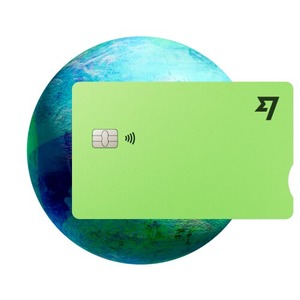
Then convert to EUR using the mid-market rate and low, transparent fees for simple spending when you travel. You can get local account details for Euro and a selection of other currencies to get paid like a local with Wise account, and you can also send payments to 160+ countries with Wise money transfer, and spend with Wise Multi-Currency Card in over 150 countries.
| Wise pros | Wise cons |
|---|---|
| ✅ Currency conversion fees from 0.42%, with the mid-market rate ✅ Convert in advance or let the card automatically switch to euros as and when required ✅ No monthly fees or minimum balance | ❌ Some transaction fees apply, including ATM fees once you’ve exhausted the no fee withdrawal limits in a given month ❌ No cash top up options |
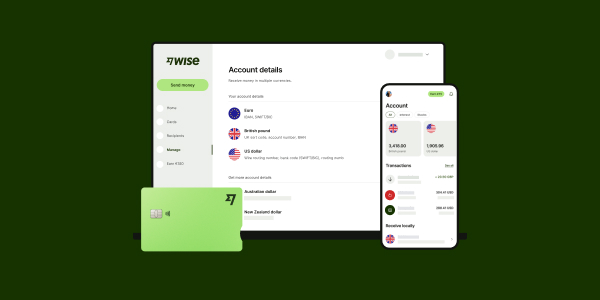
Read our Wise Multi-Currency Card review or Wise Euro Account review to learn more.
Revolut card
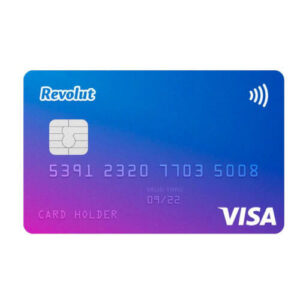 You can open a Revolut account or choose to upgrade to an account with more features, for a monthly fee of up to 16.99 USD. All accounts come with the option to hold and exchange EUR, and linked physical and virtual cards for easy spending.
You can open a Revolut account or choose to upgrade to an account with more features, for a monthly fee of up to 16.99 USD. All accounts come with the option to hold and exchange EUR, and linked physical and virtual cards for easy spending.
Depending on the account you hold you can get some no-fee currency conversion, too, with relatively low fees once your plan allowance is exhausted – 0.5% in most cases. A couple of other charges might apply, including an out of hours conversion fee of 1% which you’ll want to watch out for.
| Revolut pros | Revolut cons |
|---|---|
| ✅ Choose the account plan that suits your needs ✅ All accounts have some no-fee currency conversion ✅ Physical and virtual card options | ❌ Fees apply for the most feature packed account tiers ❌ Out of hours fees of 1% apply when converting currencies at night and at the weekends |
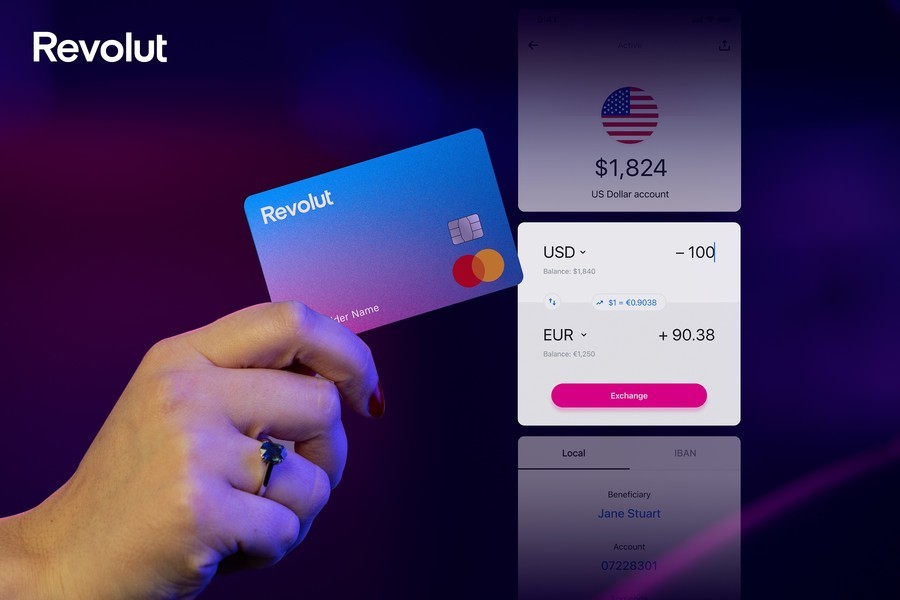
2 great prepaid Euro cards
As for prepaid Euro card options, Bluebird AmEx and Capital One Venture Rewards cards:
Bluebird American Express prepaid debit card
You can order a Bluebird prepaid debit card for free online. You’ll then be able to top up in cash or from a bank account. You can also add checks or have funds deposited by others – fees apply for some top up methods. While this card doesn’t allow you to hold foreign currencies, you won’t pay a foreign transaction fee to spend your USD balance abroad, which makes it a good choice when you’re in Europe.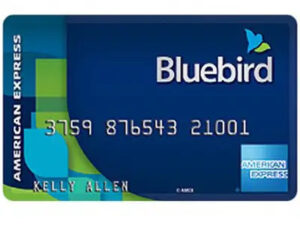
| Bluebird American Express pros | Bluebird American Express cons |
|---|---|
| ✅ Get a card for free by ordering online ✅ Top up in a range of ways in USD ✅ No foreign transaction fee when spending overseas | ❌ ATM withdrawal fees of 2.5 USD or the equivalent when overseas ❌ American Express cards are not always accepted internationally – check coverage before you travel |
Capital One Venture Rewards
The Capital One Venture Rewards card has no foreign transaction fees when you spend overseas. There’s also a comparatively low cash advance fee when you use an ATM, at 5 USD or 5% whichever is higher. You’ll need to repay your bill in full every month to avoid fees and interest, but can earn travel rewards and miles on your day to day spending.
| Capital One Venture Rewards pros | Capital One Venture Rewards cons |
|---|---|
| ✅ No foreign transaction fee ✅ Earn travel rewards on spending ✅ Get extras like lounge access and free travel insurance | ❌ Variable interest rates which apply if you don’t pay off your bill in full ❌ 95 USD annual fee, and a 5 USD or 5% cash advance fee – whichever is higher |
What is a euro card?
A Euro currency card is a card that can be used conveniently for spending and withdrawals in euros. These cards are also called multi-currency cards and they usually come with other currencies available too. You’ll be able to top up your account in USD or the currency of your choice based on the specific provider’s options, and convert to euros before you travel. That means you can plan your budget in advance, and lock in exchange rates before spending.
How do Euro travel cards work? 🇪🇺
When you get a Euro card from digital platforms like Wise and Revolut, they’ll usually be linked to a foreign currency account like a euro account, letting you hold and manage multiple currencies, including euros. These cards allow you to spend euros abroad while traveling to Eurozone countries easily and often provide competitive exchange rates alongside reduced fees to everyday bank cards, making them a popular choice for travelers.
Benefits of Euro currency cards
Getting a Euro currency card is a great bet if you’re headed to any of the 20 European countries which use the euro.
It can make it safer for spending while you’re away as you won’t need to carry a lot of cash – and your travel money account isn’t linked to your regular bank account so even if you were unlucky enough to have your card stolen, the thieves won’t have access to your main bank account.
Using a euro card while you’re away can also cut the costs of currency conversion, and allow you to get a better exchange rate. You’ll be able to add money in USD and switch to euros when you spot a good rate – and some card providers also offer better rates compared to the banks, as well.
| Pros of Euro travel cards | Cons of Euro travel cards |
|---|---|
| ✅ Cards can often be used for EUR and a range of other currencies ✅ Some providers offer preferential exchange rates to card holders ✅ Using a travel money card when you’re abroad can be safer than relying on cash or your normal card ✅ It’s usually free to spend currencies you hold in your account ✅ You can avoid currency exchange stores and simply make cash withdrawals on arrival in your destination | ❌ Different accounts come with their own fees which can include monthly charges or currency conversion costs ❌ Not all cards can support EUR, so you’ll need to make sure the one you pick is suitable ❌ Topping up your card might incur a fee, depending on how you make your payment |
Is there a euro debit card?
Yes, euro debit cards like the Wise and Revolut debit cards are widely available for US residents. These cards are designed to make spending in euros more convenient, especially for travelers going to the Eurozone.
Users can add money to their card in USD and convert it into euros either before or during their trip as needed for extra flexibility. Euro debit cards can also help manage travel expenses more efficiently, ensuring travelers always have easy access to finds in the local currency.
Is it better to take euros in cash or use a debit card in Europe?
Taking cash in euros or using a debit card when on your European travels will largely depend on what you personally find more convenient. While cash guarantees you can pay everywhere, especially in smaller establishments or rural areas, carrying large amounts of money can be risky. It also doesn’t leave a spending trail, meaning you can’t go back and check what you spent your money on or manage your finances as easily.
A debit card is a secure and convenient way of managing your money abroad, allowing you to easily track your expenses on the mobile app, and offers security features like card freezing or replacement options in case of theft or loss. You also have the added convenience of contactless payments and paying with your phone with Google and Apple Pay for extra convenience.
Is it better to pay with euros or dollars on a card?
It’s usually always cheaper to pay in the local EU currency for countries that use the euro when you’re abroad in Europe. While you can pay in US dollars using your US card, you’ll have to pay currency conversion fees, which could be high. Plus, exchange rates on your US card may not be great. That’s because your US card is linked to dollars, so they’ll need to be converted into euros. When you do this, your card’s network will apply their exchange rate, which might not always be the best one.
That’s why, to save money, you should make all your purchases in the local currency. Plus, travel money cards for Euro offer great advantages to keep the costs down. Luckily, Wise offers a convenient alternative, allowing you to hold and exchange over 40 currencies with the Wise Multi-Currency Card. Top up easily in US dollars and convert to euros using the mid-market exchange rate alongside low, transparent fees for low-cost spending across the continent.
Where can I use a Euro card?
A currency card allows you to pay in the local currency when you travel, without incurring extra costs. A EUR card is perfect if you’re headed off to any of the 20 countries which use euros, as you can top up in USD and buy Euros in advance so you know your budget in the local currency. Some cards also offer the option to convert at the point of payment, which means you don’t need to worry about getting set up in advance.
- Wise Multi-Currency Card: Can be used globally, including in all Eurozone countries and supports spending and cash withdrawals in over 150 countries.
- Revolut debit card: Designed for international use, you can make payments with your Revolut card in all European countries that accept Mastercard or Visa.
- Bluebird AmEx prepaid card: Good for global use, the card uses the Visa network and can be used anywhere where AmEx cards are accepted.
Capital One Venture Rewards card: Also on the Visa network, this card can be used anywhere Europe where Visa cards are accepted.
EUR card in the US
All of the EUR cards we have profiled above can be used in the US too – but you might find that fees apply. If you don’t hold an USD balance in your account and you use your EUR card here at home, for example, you might pay a conversion fee to switch back from euros to dollars.
Related: Best EUR account in the US
Costs of getting a Euro card in the US
Each provider will have their own fees for euro cards – which can vary pretty widely. With prepaid cards, it’s important to review the costs in detail before you pick a card as the charges applied may be quite different to using a regular debit card. You might find fees to top up, for example, and different charges for spending and withdrawing in different currencies. With credit cards, as you’d expect, there may be costs and interest charges if you don’t repay your bills in full every month.
Learn more about Wise fees here.
Euro card fees
Here’s an overview of the fees applied on the EUR cards we picked out earlier, to give you a bit of a picture. Other charges may also apply, so do check out the provider you’re choosing carefully.
| Provider/Service | Wise | Revolut | Bluebird | Capital One |
|---|---|---|---|---|
| Get a card | 9 USD | No extra fee (monthly account fees may apply) | No fee | No fee |
| Add money | Free to add money in 10 currencies with local bank details, including receiving USD by ACH | No-fees applied from debit cards and bank accounts in the US (fees may apply for some other top up methods) | Free by bank transfer, and in cash at Family Dollar (fees may apply for some other top up methods) | Not applicable |
| Account maintenance fee | None | 0 USD – 16.99 USD/month depending on tier | None | 95 USD annual fee |
| Spend in EUR | Free to spend currency you hold Convert currencies from 0.43% | No-fee to spend currency you hold Some no-fee currency exchange to plan limits, 0.5% fair usage fee after that | No foreign transaction fee – network rates will apply | No foreign transaction fee – network rates will apply |
| ATM withdrawal | First 2 withdrawals up to a combined total of $100/month for no fee*. After that: $1.50 + 2% (once you’ve withdrawn $100 in a given month, any amount in excess will be charged a 2% fee) | No fee for in network withdrawals Standard accounts: 400 USD/month out of network withdrawals with no fees, 2% after that | 2.5 USD | 5 USD or 5%, whichever is greater |
*ATM operators may charge their own fees.
What exchange rate will be used?
You’ll likely need to convert currencies at some point when you use your EUR card, so the exchange rate you get matters. If you top up in USD and convert to EUR, getting a bad rate will mean less to spend in the end. Different providers have their own approaches to calculating the exchange rate.
Wise exchange rate: Wise offers mid-market rates, and has a transparent fee which is split out, starting from 0.43%, for example.
Revolut account holders can all convert some funds no-fee, but the amount you can convert might be limited depending on your account tier. Once you’ve exhausted your allowance you’ll pay a fair usage fee of 0.5%, plus 1% out of hours costs if relevant. Other providers may take a different approach, adding a markup or foreign transaction fee when you convert or spend in a foreign currency.
Bluebird AmEx: Cards like Bluebird often use American Express exchange rates when it comes to currency conversion. The card features no foreign transaction fees, but network rates will apply, usually 2.5% of the converted amount, of which American Express retains 1%.
Capital One: Capital One doesn’t charge foreign transaction fees for purchases made in Europe and internationally, but Capital One network exchange rates may apply for currency conversions.
Check out this page to find the best Euro exchange rates.
Best euro card in the US with no fees
When choosing a euro card in the US, it’s important to understand that they usually have varying fee structures. Some may have monthly fees, while others might charge for transactions, including ATM withdrawals.
Wise Multi-Currency Card: The Wise Multi-Currency Card links to your multi-currency account and lets you hold and exchange over 40 currencies, including Euros, with no annual or monthly charges. Spend using the mid-market rate with no markups or sneaky fees and take out up to 100 USD in cash from European ATMs for no Wise fee before paying low fees for additional withdrawals. Order a card in just a few minutes and pay a one-time fee of 9 USD.
Revolut debit card: Revolut offers various account tiers, including options with no monthly fees and a plan for 16.99 USD with more features. Each plan has a linked physical and virtual card that can hold and exchange in euros, with some no-fee currency conversion for easy spending. However, fees apply once you’ve used up your plan allowance, around 0.5%, as well as 1% out-of-hours conversion fees.
Bluebird AmEx prepaid card: Bluebird AmEx prepaid cards can be ordered online for free and topped up in multiple ways with USD. There’s no foreign transaction fee for overseas spending, but it does have a $2.5 ATM withdrawal fee when using abroad. You’ll also need to check coverage before traveling, as American Express cards aren’t always accepted internationally. Capital One Venture Rewards card: With no foreign transaction fees and a low cash advance fee of 5 USD or 5% (whichever is higher) when using an ATM, this card is a convenient option for international travel. It has a 95 USD annual fee and variable interest rates that apply if you don’t pay off your bill in full every month, but it offers travel rewards on spending and extras like lounge access and free travel insurance.
Can I use my US debit card in Europe?
Debit cards from most US banks and major card networks will work in Europe, meaning you can use your US debit to make purchases and take cash out from European ATMs. However, you should be aware that you may not get the best exchange rates, and, depending on your bank and card, there might be some considerable foreign transaction fees, usually ranging from 1% to 3% of the transaction, as well as international ATM fees. Always check with your bank for specific fees and inform them about your travel plans to avoid any issues when using your card abroad.
How to get a Euro card in the US
All the providers we’ve looked at above allow you to order an EUR card online or through an app. You’ll need to have a suitable form of ID to get your card – usually a passport or driving license, and you might be asked to provide your proof of address as well. Once you’ve ordered your card it’ll arrive in the mail shortly after.
Check out the EUR card order process for the provider you prefer, so you can prepare everything that’s needed.
Related: How to get a Wise Multi-Currency Card
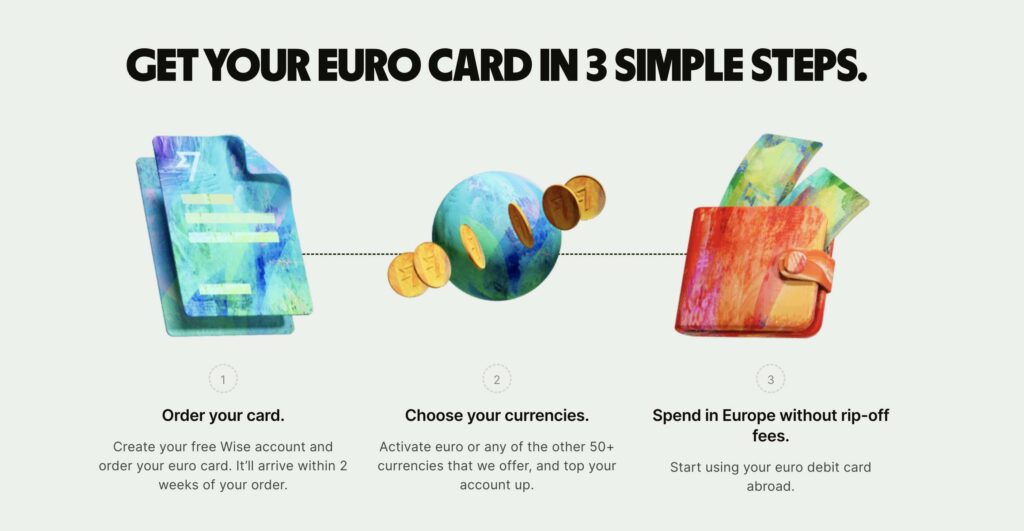 Check out our other travel money guides from this series:
Check out our other travel money guides from this series:
- Best AUD cards
- Best Mexican Pesos cards
- Best GBP cards
- Best travel cards for Europe
- Best ways to take money to Europe
Conclusion: What is the best card to use for Euros?
EUR cards are extremely useful for travelers – and can also be handy for people who shop online with retailers based in Europe. Get your euro card in advance from the US, add USD and convert to euros so you’ve got your travel money sorted and can see and manage your budget easily.
Depending on the provider you pick you might also find you get better exchange rates and lower overall costs compared to using your standard bank card overseas. Options like Wise and Revolut offer easy ways to hold and convert dozens of currencies, to make travel cheaper and easier.
Best Euro cards FAQs
What are the benefits of using a Euro travel money card?
Using a EUR card when you’re in any of the 20 euro countries can mean you get a better exchange rate and lower overall fees. You’ll also be able to manage your budget in euros easily.
Are Euro money cards available in the US?
Yes. You can get a card with low or no foreign transaction fees from a bank like Capital One, a network like Amex – or pick an online specialist provider like Wise or Revolut for a card and account that offers even more features.
How much does a Euro travel money card cost?
Most EUR cards have low or no initial fees, but you’ll need to look at the transaction costs that apply when you use your card. These costs include fees for topping up, ATM withdrawal charges and inactivity or closure fees.

